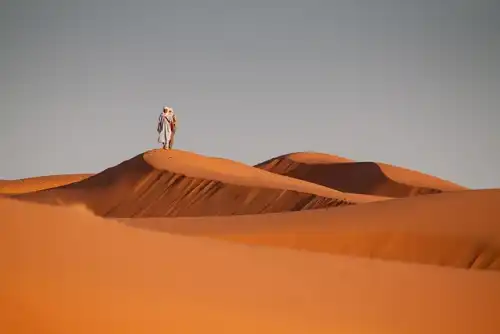When Is the Best Time to Travel to Morocco?
Thinking of heading to Morocco? With golden desert sunsets and lively markets, every moment has something special to offer. But to really enjoy your trip, choosing the right time to go makes all the difference. This guide will help you figure out the best season based on what you want to see and do.
Key Features:
- A month-by-month weather breakdown to guide your itinerary.
- Best seasons for festivals, desert treks, and coastal getaways.
- Tips for budget travelers and crowd-avoiders.
- Key information about the Morocco eVisa for smooth entry.
- What to pack depending on travel months.
- Regional insights: Marrakesh, Fes, the Atlas Mountains & more.

Seasons in Morocco: What to Expect Year-Round
Morocco has all kinds of landscapes. From snowy mountains to hot, sandy deserts, the country offers a wide range of weather conditions. That means the climate can vary a lot depending on where you are. While some regions stay cool and breezy, others can be hot and dry at the very same time. So, when to travel to Morocco really depends on the kind of experience you're hoping to have.
Spring (March to May) and fall (September to November) are often considered the best times to visit Morocco. The weather is nice and not too hot or cold during these seasons, which makes it great for getting around and seeing the sights. Cities like Marrakesh, Fes, and Chefchaouen are lively but not too crowded, so you can enjoy them without feeling rushed. The landscapes feel full of life, adding an extra color to your trip.
Summer (June to August) can be very hot in Morocco, especially inland or in the Sahara. But coastal areas like Essaouira and Agadir offer a cooler, breezy escape. On the other hand, Winter (December to February) is chilly in the mountains and quieter in cities. That is great for budget-friendly, crowd-free travel.
Peak Months vs. Hidden Gems: What Suits Your Style?
If you’re into energetic crowds, local festivals, and street performers, consider planning your trip for April, May, or October. These are Morocco’s golden months, packed with color, culture, and great weather. Cities like Fez, Casablanca, and Marrakesh come alive during these months with music, art, and street parades. Big events like the Fez Festival of World Sacred Music and the Marrakesh Popular Arts Festival make the atmosphere even more exciting and fun to explore.
If you’d rather avoid the crowds and enjoy a more peaceful experience, January and February are a great time to go. The Sahara feels calm and almost otherworldly during this time of year. The cooler temperatures make camel rides and desert tours much more comfortable and enjoyable.
In the north, Tangier and the blue streets of Chefchaouen stay nicely calm and peaceful in winter. It’s a great time to enjoy their beauty without big tourist crowds.
Budget, Weather & Adventure: Matching Your Needs
If you're looking to save money, late fall and winter (except around holidays) are your best times for visiting Morocco. Flights and hotel prices are usually lower, which means your budget can stretch further. Markets are also less crowded, giving you a better chance to find good deals and enjoy shopping without the rush. Plus, with fewer tourists around, your trip can be more relaxed and authentic.
Adventurers should head south for desert tours in March or April, or in October. For hiking in the High Atlas Mountains, late spring or early summer is the best time. During those seasons, the weather is comfortable, and the trails are open. If you want to head to the coast, consider visiting between June and early September for pleasant weather and cool ocean breezes.
Morocco eVisa: What You Need to Know
Before you start planning to travel to Morocco, don’t forget your Morocco eVisa. It’s a convenient online solution launched in July 2022. The eVisa typically takes 1-3 business days to process. A faster, 24-hour premium option is available for your urgent travel.
Once approved, the eVisa is valid for 180 days. It allows for a 30-day single-entry stay, with the possibility of extension within Morocco. To apply, travelers must submit a form, upload a passport (valid for 6 months), a photo, travel details, accommodation proof, and show enough funds. Payment is made online, and the evisa is delivered via email.
Travelers from non-visa-exempt countries, or those with valid Schengen, US, UK, or similar visas or residency, can apply easily. It’s best to apply at least 7 days before travel.
Note: The Morocco Electronic Travel Authorization (ETA) is another digital entry permit. Which is available exclusively to citizens of Guinea, Mali, and the Republic of the Congo. It allows visa-free travel for up to 90 days and must be obtained online before arrival, with approval linked directly to the traveler’s passport.